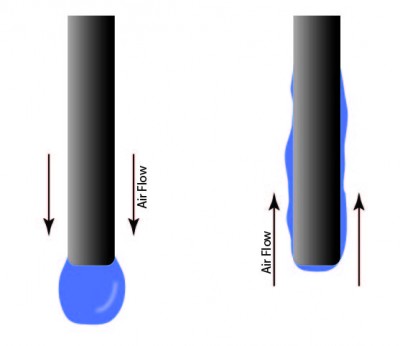Drying is almost always the longest step in a cleaning process. Because of this, anything that will speed up the drying process is of special interest to the process engineer. Hot air drying is, by far, the most common means of drying used in the industrial parts cleaning arena. Major variables in hot air drying are temperature, airflow and relative humidity. Increasing temperature or airflow or reducing relative humidity (often by adding heat) all contribute to the speed at which water will evaporate from a surface. Another factor that has a significant effect on the speed of evaporation of a given volume of water is the amount of surface area interface of the liquid with air available for the evaporation to take place. A larger surface area interface results in faster evaporation. In most cases, water tends to drain to the bottom of a part due to gravity resulting in drops of water at the bottom of the part. A water droplet tends to pull into a spherical shape as a result of surface tension and, as such, presents the minimum amount of surface area per unit of volume. This, obviously, is not the best condition for drying by evaporation.
Upflow vs. Downflow Hot Air Drying –
The direction of airflow in a dryer, if it has sufficient velocity, can help increase the surface area interface available for evaporation. If airflow is from the top to the bottom of a dryer (which is most common), the airflow works along with gravity to encourage the formation of drops of water at the bottom of a part.

Changing the airflow direction to from bottom to top can (and again this depends on air velocity), reverse the process of drop formation by pushing the water up so that it is distributed over more of the surface of the part. This, in turn, increases the surface area of the liquid/air interface available for evaporation. Increased surface area may result in an increased speed of evaporation and faster drying
It can’t be stressed enough that upflow will only be of benefit if the velocity of airflow is sufficient to overcome the effects of gravity and surface tension. It could be argued that increasing the air velocity in a downflow scenario could increase the likelihood water droplets clinging to the bottom of a part will be physically removed (blown away).
To the best of my knowledge, the upflow concept is theoretical (as are many things in the cleaning world). I don’t know that there have been any A-B tests conducted under controlled and documented conditions. If readers are aware of any, I would enjoy seeing the results along with any analysis of what might have contributed to the outcome. Specifically, what air flow was required to make upflow beneficial.
Thanks!
– FJF –



 English
English Spanish
Spanish Chinese
Chinese Canada
Canada Mexico
Mexico United Kingdom
United Kingdom



